Dash 7 Homepage (original) (raw)
The last changes to the page are listed at the bottom of this page.
This non-commercial page is a private homage to the DeHavilland Dash 7 STOL airliner, designed and built by deHavilland of Canada at Toronto Downsview Airport between 1973 and 1988.
I have no affiliation to deHavilland, Bombardier,Boeing, or any company mentioned on this website and respect their copyrights and trademarks.
I learned to know and love the Dash 7 during 8 years as a First Officer and Captain with Tyrolean Airways. My first flight as a Dash 7 copilot trainee was on March 5th, 1990. The biggest airplane I had flown before was a Cessna 210. I will always be grateful to the Dash 7 for the easy transition from general aviation to airline flying. My last Dash 7 flight as captain was on May 6th, 1998. In between I flew about 2500 hours on the type.
Even as I moved up (?) to faster and more capable turboprops and now to quite modern twinjets, I will always fondly remember the Dash 7. I would like to keep the memory of a rather unusual plane alive on these pages.
More than 40 years after its first flight and almost thirty years after the end of production there still is no aircraft of comparable capability AND size and while operating economics have mostly dictated the end of Dash 7 operations in the busier parts of the first world, a couple dozen are still busy serving areas where these capabilities are sorely needed.
This page is not "mine" but mostly a collection of bits and pieces other netizens, pilots and passengers have have sent me. As this is strictly a hobby I am always late in incorporating new material which is nevertheless always welcome.
Look forward to a scan of a Dash 7 sales brochure I just found on Ebay.
If you believe any contents of this website to be in violation of your rights or any laws, please send me a mail and I will remove them.

Pictures

This used to be my view of the world for several years.
For a partly illustrated list of all Dash 7s ever built click here.
I am still working to scan my (small) collection of Dash 7 pictures and find a compromise between acceptable quality and the small size required due to server limitations. Send a mail to dash7@at@aon.at if you like more pictures or if you have pictures for me. (please remove @at for SPAM protection.)
Tyrolean Airways Dash 7 with additional TAT markings at CourchevelAirport, France. Pictured during the Winter Olympics 1992. Click here. (32K)
More Courchevelpictures.
The author standing on a FAR Airlines Dash 7. (s/n 22 at Milano Linate, 1995) Click here. (22K)
A EuroCity Express Dash 7. Picture by Michael Blakesley who maintains a very nice webpage on London City Airways. Click here. (80K)
John Powellsent the following pictures of a London City Airways G-BOAX(42K) at the Biggin Hill Air Fair in July 1988. 12-minute shuttle trips between London City (LCY) and BGN were flown to bring air enthusiasts to the fair. Another photo shows G-BOAZ(57K) in the July 1989 morning sun after a Paris-CDG night stop. This airplane was the last but oldest to join the London City Airways fleet and was formerly operated by Maersk Air.
Final approach to runway 04 at Roi-Namur, Marshall Islands. Picture by Leon Burdick.Click here. (29K)
Hangar shot of two Dash 7s from the Marshall Islands operation in support of the Space and Missile Defense command.Picture by Paul Wiebe.Click here. (52K)
Some Dash 7 pictures from the Tyrolean history book.
Links to Dash 7 pictures:
Lots of high-quality photos are available in the Dash 7 section of Airliners Net. If the direct link doesn't work please click
Dash 7 page at Canada's Digital Collections. Includes some technical drawings. More pictures can be found here.
A Dash 7 R/C plane
A lot of Dash 7 photos from Plymouth City Airport (mostly Brymon)
Commercial Dash 7 Photos
Dash 7 at National Aviation Museum of Canada, Ottawa
Greenlandair Dash 7
More pictures are in the liveriessection.
If you want to buy or sell a Dash 7 free aircraft classifieds are available here.
Airplane Description
The de Havilland Canada DHC-7 ("Dash 7") was the first STOL Airplane certified according to FAR25 criteria for transport-category aircraft. It first flew on March 27th, 1975 and the first airplane was delivered to Rocky Mountain Airways on February 3rd, 1978. After delivery of the 100th airplane in 1984 further sales were slow and after de Havilland was taken over by Boeing production ceased. Many small airlines found a four-engined airliner too costly to operate and the "little sister" Dash 8 could fly most of the routes faster and more economically. City center STOLports did not materialise as expected and there simply were not enough routes to remote airfields with short runways that would still generate enough traffic to justify use of a 50-seater. The last Dash 7 (S/N 113) was delivered to Tyrolean Airways in 1989 and the programme was closed with a loss of about 145 million Euro. (A fuselage for a 114th aircraft was partly completed. Due to lack of customers work on the wing was not begun and the fuselage has since been used for various other purposes.) In recent times a number of Dash 7s were completely overhauled, re-engined and converted to O-5A, EO-5B and RC-7B surveillance planes for the US Army. See this excellent site for more info.
Construction and technical Details
To achieve optimum short take-off and landing performance the aerodynamics of the airplane have to be optimised for maximum lift at minimum airspeed. If a reasonable cruising speed is desired as well, this requires sophisticated wing flaps. De Havilland developed a system of dual fowler flaps for the Dash 7. The flaps cover 75% of the trailing edge of the wing. Up to 25� they extend together and for 45� the rear part of the flaps is extended a further 20� by hydraulic jacks. At touch-down hydraulic pressure to the extension side is dumped allowing constant pressure to the retraction side to retract the flaps to 25�, thus reducing lift and increasing brake efficiency. The same happens if the power levers are advanced beyond 50% during a go-around. Drag is reduced and the loss in lift is more than compensated by increased power.
To achieve sufficient roll control despite the small ailerons two roll spoilers on each wing extend together with the aileron. By reducing lift and increasing drag on the inside wing in a turn they augment roll control. With all three landing gear on the ground and the power levers below 50% the spoilers extend to kill lift and increase drag on landing or aborted take-off. For the same purpose two extra ground spoilers on each wing extend on mainwheel touchdown.
Further aerodynamic "tricks" include different wing profiles for the outboard and inboard wing, a drooped leading edge, and a multitude of small fences, fins and "teeth" to energize and control airflow.
Four engines leave the airplane with 75% of total power and less pronounced asymmetric thrust in case of an engine failure. This reduces Vmc which in turn allows lower take-off speeds and shorter take-off runs.
The slipstream of the propellers covers a large portion of the wing, further increasing lift. This is also valid in the opposite direction with sudden power reductions during the landing flare killing a lot of lift rather abruptly, causing "firm" arrivals and light bruises to the pilot's ego. This effect is enhanced by the adjustment of the propellers which produce drag rather than thrust at flight idle. This de Havilland technology allows precise glidepath control by rapidly varying total drag/thrust without any aerodynamic devices. (Flaps 45� and flight idle result in about -20� pitch at Vfe45). With only 1200 RPM for take-off and as little as 900RPM in cruise the Dash 7 is a good neighbour at airports in the middle of built-up areas. Props are reversible for deceleration on ground but most of the braking is performed with anti-skid equipped wheel brakes (nosewheel brakes were optional). On a maximum performance landing the airplane will be stopped before the engines even reach maximum reverse thrust.
The Dash 7 can be certified for ILS approaches up to 7.5� - a normal ILS having 3� - and CAT 2 approaches down to 100ft/30m decision height and 300m/1000ft RVR.
Despite all this aerodynamical tricks the Dash 7 is no thoroughbred in cruise. Cruising altitudes above 17.000ft are advisable on cool days only, with the climb rate above FL100 solidly below 1000ft/min and a maximum cruising speed of about 215KTAS.
Take-off and landing is where the Dash 7 shines. Maximum Vr (rotation speed) is 85kts with an empty plane lifting off at 70kts. With maximum flaps Vr (speed over threshold) is a leisurly 83kts at max landing weight and 70kts for an almost empty plane. This allows for a landing roll of as little as 125m/400ft; rumour has it, that Dash 7s have turned off at by-pass intersections 70m/230ft beyond the threshold..... Spoilers, anti-skid and reverse make all this feel a lot more solid than light aircraft with comparable performance (e.g. C210, C340).
Technical Data
| Wingspan | 28,35m | 93ft |
|---|---|---|
| Length | 24,58m | 80ft 7.7" |
| Height | 7.98m | 26ft 2" |
| Wing Area | 79,9m2 | 860sq.ft |
| Wing Loading | 247kg/m2 | 50.6 lb./sq.ft |
| Operating Weight | 13.2t | 29.000lb. |
| Maximum Take-Off Weight | 19.96t | 44.000lb. (47.000lb. for -150 conversion) |
| Maximum Landing Weight | 19.05t | 42.000lb. |
| Maximum Zero Fuel Weight | 17.69t | 39.000lb. |
| Maximum Passenger Capacity | 54 | Tyrolean: 48 |
| Maximum Fuel Capacity (Jet-A) | 4.5t | 9.926lb. (16.000lb. for -150 conversion) |
| Engines | 4 Pratt &&; Whitney PT6A-50 |
|---|---|
| Maximum Take-Off Power | 1120 SHP |
| Maximum Continuous Power | 973 SHP |
| Maximum Climb/Cruise Power | 900 SHP |
| maximum cruising speed | 231 KTAS @ 8.000ft |
|---|---|
| 227 KTAS @ 15.000ft | |
| Maximum Operating Altitude with passengers | 20.400ft |
| Maximum Operating Altitude w/o passengers | 25.000ft |
| Take-Off Distance (FAR25/ISA/sea level) | 689m |
| Landing Distance (STOL/ISA/sea level) | 594m |

This is a size comparison between the Dash 7 and the B737-300 (thanks to Ito Noriyuki)

This is a photo of a Dash 7 flight deck by Paul Wiebe.
De Havilland Canada
The de Havilland Aircraft of Canada was founded in 1928 as a subsidiary of the English de Havilland aircraft factory. Until WW2 several versions of English-built de Havilland Moths were assembled and sold in Canada. During WW2 two-engined "Mosquito" fighter/bomber/reconnaissance planes were built in Toronto.
After WW2 the DHC-1 "Chipmunk" was DHC's first "own" model, followed by the DHC-2 "Beaver" and DHC-3 "Otter", two high-wing utility planes tailored for the Canadian North. They were followed by the DHC-4 "Caribou" and DHC-5 "Buffalo", two twin-engined high-wing STOL transports. The hugely successful DHC-6 "Twin Otter" continued the backcountry success of the Beaver and Caribou with modern turboprop engines and tricycle gear.
Development of the Dash 7 began in 1972, followed in 1978 by the Dash 8. In the mid-80s de Havilland Canada was sold to Boeingand renamed the "Boeing Canada, de Havilland Division". To restore profitability the Dash 7 and Twin Otter production lines were closed and the company concentrated on the more successful Dash 8. In 1992 de Havilland was sold to Bombardierand together with Canadair of Montral designated the Bombardier Regional Aircraft Division (BRAD).
Other Dash 7 Links
And even more Dash 7 information at XdH Aviation Services
Ito Noriyuki who contributed some of the photos on this page has a nicePropeller Airplane site which also features the Dash 7.
PlaneSalehas a nice info page with technical details and a cost analysis.
Greg Goebel on the RC-7(B)
Dash 7 Accident Database
Stories
Bird Encounter by Danny Fyne
Our Love of Flight is but a Thorny Rose by Sky Masterson
Dash 7 Flight Simulator Files
A flight simulator for the Dash 7 operated by Flight Safety International is available at TorontoDownsview Airport (Canada). It was not built before the early nineties, long after the last Dash 7 had left the factory.
If you don't want to travel to Toronto to experience the Dash 7 you can click here to download Tyrolean Airways Dash 7 files for Microsoft Flight Simulator made by Dennis Wasnich(82K).
Milton Shupeis currently coordinating development of a Dash 7 for FS2002. The project progress page is here.
A review of the FS 2002 Dash 7 model is available here.
 CourchevelAirport
CourchevelAirport
Courchevel (CVF, LFLJ) is an "altiport" in the French alps. It is located in the "trois vallees" about 100km SSW of Geneva and about 50km SSE of Montblanc at an elevation of 6369 to 6580ft (1941 to 2006m) just above the skiing resort of Courchevel 1850 (part of the "trois vallees" skiing area). Its single runway 05/23 is 525m (1720ft) in length with a slope of 12 to 18%, making it (as to my knowledge) the highest hard-surfaced airfield in Europe.
Former Courchevel Captain Gerhard Beer has given permission to publish this German article about CVF ops written for the Tyrolean employee magazine.
Courchevel Operations were special because there was no way to abort the take-off after brake release, so special power setting procedures ensured that even a combination of engine failure and nosewheel steering failure could be handled safely.
It is a testament to the design qualities of the Dash 7 that she could land in Courchevel without weight limitations and incurred take-off weight limitations only under low pressure/high temperature conditions and even then those limitations were not severa and usually not operationally relevant.
You could also say that it's not that hard to take off, when gravity takes care of most of the acceleration required.

Courchevel, view of platform and runway from above, photo by Capt. Gerhard Beer

Tyrolean Dash 7 taking off in Courchevel

Tyrolean Dash 7 landing in Courchevel

ooh sure; there is a runway....... (photo by Markus Herzig. Click herefor his homepage.)
Martin Reifferhas programmed a Courchevel scenery for FS2000. This is just a first glimpse.....
For more information and ordering go to the Reiffer FlightSim page.
Tyrolean's Dash 7 fleet 1980-1999
S/N 22
Originally delivered to Tyrolean Airways in 1980 as Tyrolean's first aircraft. Registered as OE-HLS. Later re-registered OE-LLS. In service with Tyrolean until 1995. Sold to FAR Airlines of Milano, Italy and re-registered I-FARB after a very protracted type certification in Italy.
According to an undated newspaper clip s/n 22 has come to a a sad end: "Long time Guernsey resident, the ex-Italian Far Airlines DHC-7 I-FARB, that has been with Anglo-Normandy Aeroengineering since a major check in 1999, remained on the island because of unpaid bills. It has now been stripped of engines and all other usefull equipment and was broken up and reduced to scrap at the end of March [2001]". A handwritten addendum reads: who added: "...what daredevil pilots in hair-raising ground-attacks from the big Courchevel jump to the sand pits of Milos and the Paros quarry didn't do...." (reported by Markus K�chle)
What a sad end for our first airplane......
S/N 50
Delivered to Tyrolean Airways in 1980. Originally registered OE-HLT, re-registered OE-LLT. Swapped for s/n 113 in 1988/89. Converted to CAA specifications for service with Brymon Aviation.
S/N 113
Last Dash 7 completed. Originally configured for Brymon Aviation according to CAA specifications. Re-configured for Tyrolean Airways, it was ferried from Southend to Innsbruck on Dec. 19th, 1988, certified by the Austrian CAA (BAZ) on Dec. 29th and entered service with Tyrolean on December 30th/31st, 1988 as OE-LLU. Withdrawn from regular scheduled services in 1996 it was used as stand-by and ad-hoc charter aircraft until late 1997 showing a new all white livery with Tyrolean logo aft of cockpit windows and on vertical tail.
In late October 1999 S/N 113 is seen in Innsbruck in Greenlandairlivery (click herefor a picture). On November 18th, 1999 OE-LLU left Innsbruck after 11 years, ending the Dash 7 era at Tyrolean after a total of 19 1/2 years :-( (After flying as OY-GRF for Greenlandair named "Sululik" (Seagull) it was at Toronto Island Airport in 2016 awaiting refurbishment for new duties. Click Here to view another photo. (airliners.net)
A small note on callsigns at Tyrolean
Tyrolean airplanes were initially registered OE-HLx according to their weight class (below 20 metric tons / 44.000 lb.) and later re-registered OE-LLx when Tyrolean received a full scheduled services operator certificate (allowing use of the "L" prefix).

OE-HLS (S/N 22, foreground)arriving from the paintshop in new livery while OE-HLT (S/N 50)still shows the original Tyrolean livery and is readied for ferry to the paintshop. Innsbruck Airport, photo by Siegfried Steinlechner

OE-HLS(Tyrolean livery) together with YU-AIF (now S5-ACB, S/N 92) leased from Inex Adria Airways while OE-HLTwas painted. Photo by Siegfried Steinlechner

OE-LLUreturning from the paintshop in full Greenlandair livery. October 17th, 1999. Photo by Hawkeye.
Special Mission
While many of the remaining Dash 7s are used for special transport needs in remote areas, this is what the airplane was designed for. Some Dash 7s have been specially modified to accomplish special missions such as aerial surveying and reconnaissance.
The Canadian Ice Serviceuses the one and only Dash 7IR-150 for ice surveillance in the Canadian Arctic. It is operated for Ice patrol by Bradley Air Services / First Air for the Canadian government. From January to March the aircraft is based at Summerside PEI, patrolling the Gulf of St. Lawrence. From early April the straight of Belle Isle, Labrador coast, and northern Newfoundland are patrolled from Gander. June is a maintenance period as there is no sea ice in open shipping areas. From July to October the arctic is monitored from Iqaluit (Frobisher Bay, YFB) with sub-bases at Resolute Bay, Inuvik, Fairbanks, and Thule AB (Greenland).
The primary support is to the Canadian Coast Guard (CCG) and its fleet of icebreakers who in turn support all shipping in canadian waters. A secondary role is iceberg surveillance as part of Canada's contribution to the North Atlantic Ice Patrol.
On deployment the aircraft has an aircrew of pilot, co-pilot, and engineer, with a mission crew of 4 ice service specialists and an electronics technician. Maintenance in done in the field with the aircraft coming back to Ottawa only between seasonal deployments, at which time any required major servicing is performed.
C-GCFR (s/n 102) was the first 150 series made. It was delivered in May, 1986 and holds 18,000 lb. of fuel (with two 4,000 lb. auxiliary tanks inboard of the #2 and #3 engine nacelles.) Fuel dumping is available for the auxiliary tanks to attain maximum landing mass in case of emergency. For normal operations only around 14,000 lb. of fuel are loaded. The aircraft can stay airborne for almost 16 hours with VFR reserves. Due to the extra equipment its operating mass of 31,000 lb. is slightly higher than the usual airline version. Althought the aircraft was built for a 49,000 lb. MTOM it is certified for 47.000 lb. only. (Which is quite a lot of mass to lug around in case of an engine failure anyway....).
It has an Observatory dome on top of the fuselage and bubble windows out each side and. A SLAR (side looking airborne radar) can take a continuous picture 100 miles wide. (50 miles on each side of the aircraft). The SLAR can see the ground or icebergs through cloud and at night. Radar and camera images can be sent to ground stations and CCG icebreakers via an S-band downlink transmitter. A glass bottom bay holds a Zeiss large-format mapping camera to take pictures out the bottom of the aircraft.
Additionally, it has a drop chutein the back to drop AXBTs (airborne expendable bathytherms that measure and transmit sea temperature from surface to floor) as well as beacons used to measure sea ice and iceberg drift. It has NATO type hard points under the wings but these are not normally used.
An APUis fitted in # 4 engine nacelle. Further equipment includes dual IRS and GPS (Omega and Loran C were fitted but have been removed), airborne management computer and peripherals, HF fax transmitter, M-Sat(voice & data). This aircraft reportedly cost the Canadian government 38 million dollars to build. (Info by Paul Hobson & Canadian Ice Service)
Additional info:
engines P&W PT6A-50 (as per dehavilland specAEROC 7.1*G,31 Issue "6" Rev.1(DHC-7 150 Series) as amended.
avionics: as per dehavilland spec AEROC 7.1.G*3, Issue "6", Rev.1 (DHC-7 150 Series) as amended.

C-GCFR at Iqualuit (Frobisher Bay), Nov 7th, 2000 (photo by Siegfried Lenz)

C-GCFR over Bellot Strait. (unknown photographer on SEDNA IV, photo supplied by Hugh Forbes)

Nice side shot showing observation dome and SLAR antenna (photo by Paul Hobson)
Click Here for a shot in landing configuration.
Fugro Airborne Surveys have selected the Dash 7 to carry their MEGATEM airborne electromagnetic (AEM) survey system. Their Dash 7 is equipped with an impressive antenna system and various other appendages.

Fugro Dash 7 C-GJPI (s/n 36) with MEGATEM aerial survey system over Gatineau Park (photo courtesy Fugro Airborne Surveys.)
US Army RC-7B "Crazy Hawk" Reconnaissance Plane - a number of Dash 7s were completely overhauled, re-engined and converted to O-5A, EO-5B and RC-7B surveillance planes for the US Army. Also see this site for more info.
Dash 7 Liveries
The main reason for this section is that I don't know the serial numbers of the airplanes shown (yet), so this is mainly a collection of different liveries.
Some drawings of Dash 7 liveries are also available on Karl Mesojednik's Aircraft Art Page.

G-BRYB of Brymon Airways in standard livery (photo by Richard Hunt)
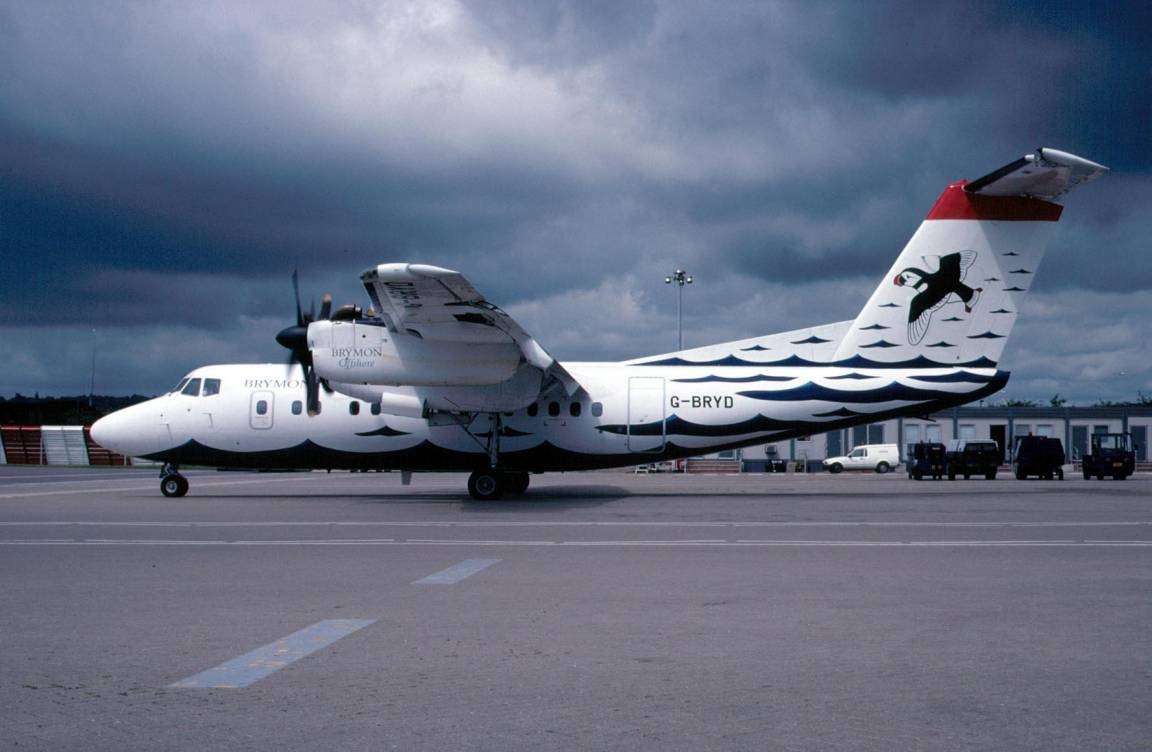
G-BRYD of Brymon Airways in special "Puffin" livery (photo by Richard Hunt)
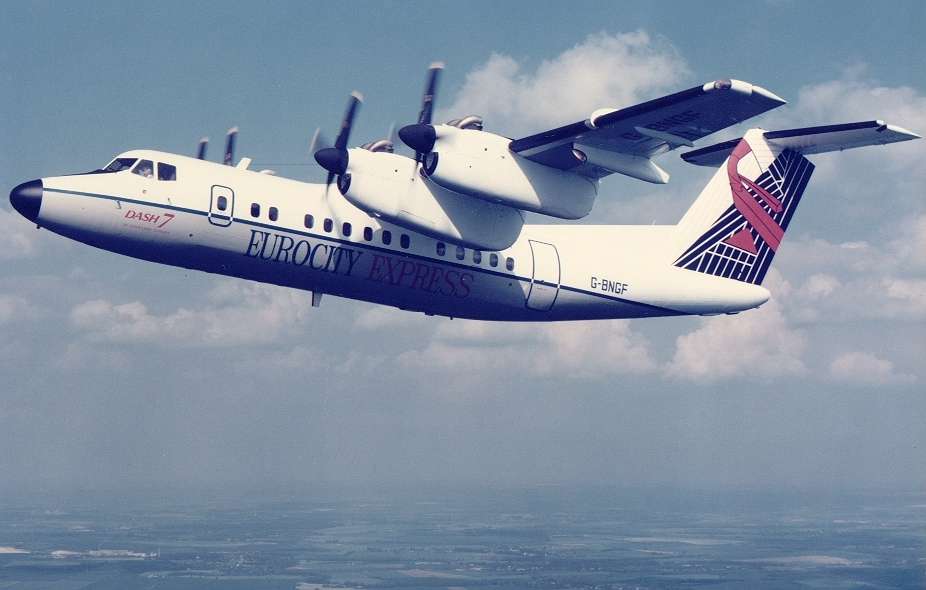
Commercial photo of EuroCity Express' first A/C G-BNGF (sent by John Powell). Click herefor full size (413K).
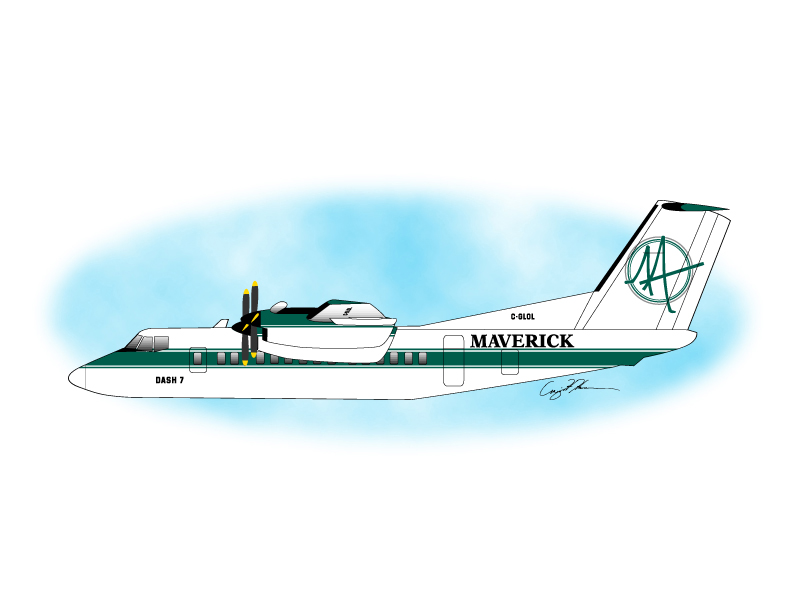
Drawing of Maverick Airways livery by Craig Hansen

Drawing of Rocky Mountain Airways livery by Craig Hansen

Drawing of Golden West airplane leased to Rocky Mountain Airways. Craig Hansen

PanAm Express Dash 7 in Syracuse, NY (?), photo John "Hutch" Stewart, submitted by Glen Charbonneau
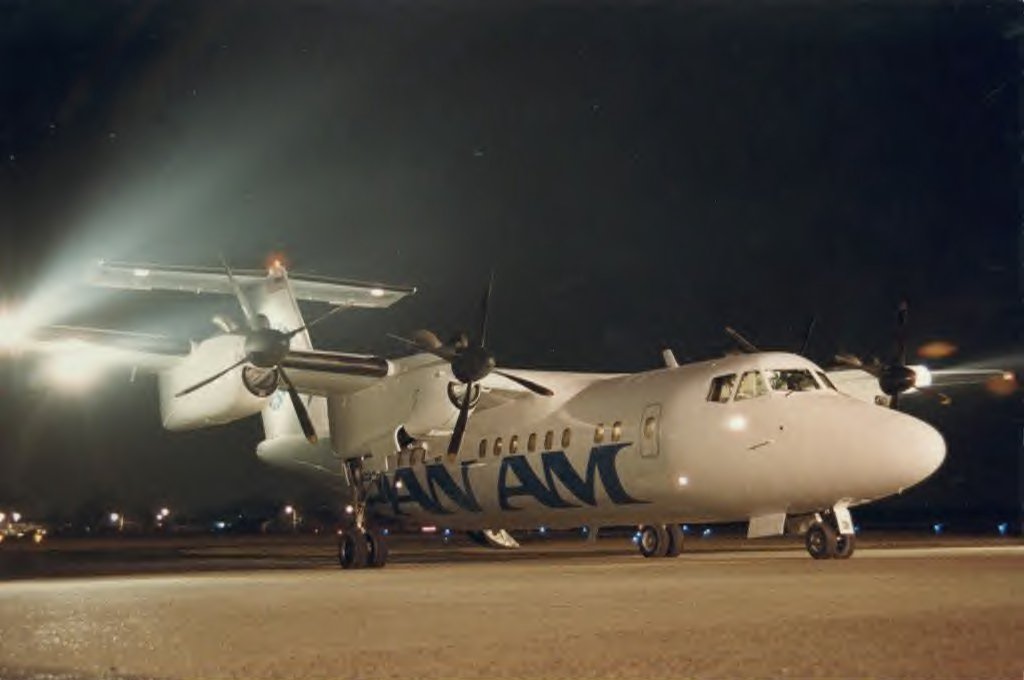
PanAm Express Dash 7, photographer unknown, submitted by Glen Charbonneau
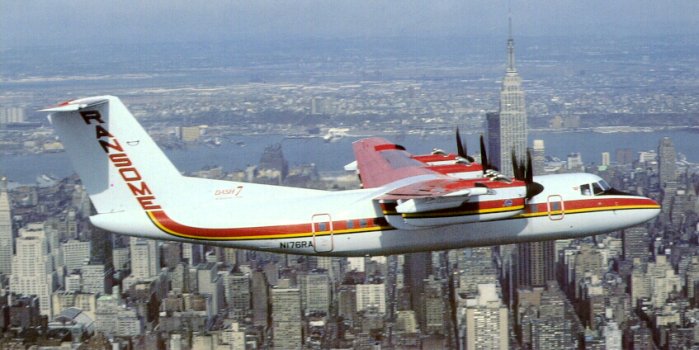
Ransome Airways Dash 7 over Manhattan, photographer unknown, submitted by Glen Charbonneau
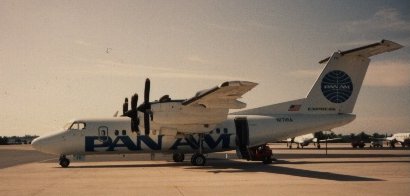
PanAm Express Dash 7 in Miami, FL, July 1991, photo by Glen Charbonneau
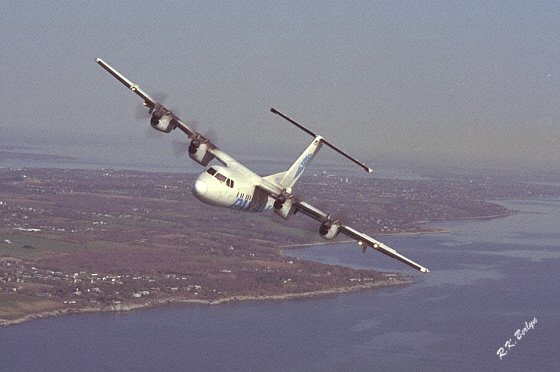
very nice shot of PanAm Express Dash 7 over Narrangansett Bay, RI, ca. 1988, photo by R.K. "Bob" Berlyn, submitted by Glen Charbonneau
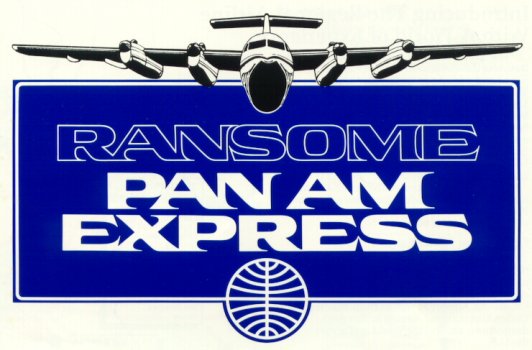
Ransome Airways was bought by PanAm in 1986 and renamed PanAm Express. (submitted by Glen Charbonneau)

Rio Airways Dash 7 (photo Bruce Goyins)
Dash 7 Operators
For the time this is just an alphabetical list with occasional links. Additional info will be added according to availability. The List does not distinguish between past and present operators.
Adria Airways
Aerovias DAP (Antarctica XXI)
Aerovias Nacionales de Honduras SA (ANHSA)
Air BC
Air Guin�e
Air Greenland (formerly Greenlandair/Gronlandsfly)
Air Kenya
Air Niugini
Air Pacific
Air Tindi
Air West
Air Wisconsin
Alas Chiricanas, Panama
Alyemda - Democratic Yemen Airways
American International Airways
Arkia
ASA - Atlantic South East Airlines
Asian Spirit Airlines
Atlanta Express
AVCOM Aviones Comerciales de Guatemala
Berjaya Air, Selangor, West Malaysia
Bradley Air Services / First Air
Branson Airlines
British Midland Airways
Brymon Airways
Canadian Armed Forces (as CC-132)
Canadian Ice Service
Carbocol Colombia
City Express
Conair Avaiation
Continental Express
Emirates Air Service
ERA Aviation (ERA Jet Alaska)
FAR Airlines
Far West Airlines
Fugro Airborne Surveys
Golden Gate Airlines
Golden West Airlines
Gulfstream International Airlines
Hawaiian Air
Hellenic Star
Henson Aviation (Piedmont Regional)
Jetcraft Aviation, Australia
Linea Turistica Aerotuy, Venezuela
London City Airways
Inter Air
Lineas Aereas Kaiken
London City Airways (previously Eurocity Express before it was found out that the name had already been taken by the train :-)
Maersk Air
Mark Air
Maverick Airways
Mobil Oil Indonesia
Newmans Air
PanAm Express (former Ransome Airlines became TWA Express after the demise of PanAm)
Paradise Island Airways, also operated as USAir Express, now merged into Gulfstream International Airlines
Pelita Air Services
Ransome Airlines (also as Allegheny Commuter and Pan Am Express - see above)
Rio Airways (based in Killeen, Texas, out of business in spring 1987)
Rocky Mountain Airways (first Dash 7 operator)
Skyline, Nigeria
Southern Jersey Airways (an Allegheny operator)
Spantax
Star Asia
Tassili Airlines
Time Air
THY - T�rk Hava Yollari
Trans Capital
Trans World Express (formerly Ransome Airways and PanAm Express)
Tropical Airways
Tyrolean Airways
Venezoelan Navy
Voyageur Airways
Wardair
Wider�es Flyveselskap, Norway
Dash 7 Literature
Apart from the Technical Manuals by de Havilland and Flight Safety there seem to be no dedicated Dash 7 books in print.
The closest I have come so far is _A case study on the de Havilland Family of STOL Commuter Aircraft_by Richard D. Hiscocks, former DHC VP Engineering, published by the American Institute of Aeronautics and Astronautics (AIAA) which I found at amazon.com.
The technical data on this page is from this booklet as well as some other aircraft encyclopedia.
Jane's Transport Press' Air Portfolios 6 by Paul R. Smith covers the DHC-6 (Twin Otter), DHC-7 and DHC-8 but is out of print.
CANAV Books have published an excellent general history of de Havilland Canada by Fred Hotson which is available by mail order.
With kind permission of the author I have scanned a flight report from the 1991 edition of the UK Pilotmagazine.
Not so serious......
The Dash 7 is a cross between a shirt-and-tie city (center) slicker and outback workhorse. Pilots either love or hate her with little in between. Its less than spectacular performance in the flight levels has done its share to build up a certain reputation. I try to compile some nicknames and sayings here.
- The Quad Otter (Thor Johnson)
- Heuwender (hay turner, tyrolean lore)
- four-engined hot-air balloon (origin unknown)
- 50-passenger elevator (Craig Hansen)
- more wanted ....
I got a mail by Capt. Tom Bannon who has flown 36 different Dash 7s and gave a lot of infos regarding "missing" numbers. His 36 S/Ns flown are quite a lot more than my meagre two. Anyone out there who claims a higher number or simply wants to get on the list between Tom and me? Just send me a mailwith some info.
Barry Hubbard tops this with a count of at least 46 Dash 7s but adds that he was Chief Production Test Pilot for the Dash 7. So second and third places (or even new records) for other than DHC employees are still open.......
"Cameo Appearances"
While watching TV I suddenly saw a Dash 7 right in the middle of a feature movie. Celebrity appearances in TV shows are called "cameo" appearances so I added this section to the Dash 7 homepage to list all Dash 7 spottings in movies, etc. Links are to the IMDB database.
- The Odd Couple II: Dash 7 with "westward express" (probably fictitious) labels shown during boarding and with take-off and airborne shot. Interior shots most definitely not from a Dash 7 but standard hollywood commuter interior :-) The aircraft was N46RM, operated at the time by Maverick Airways of Denver, CO. The aircraft was flown in 1997 from Denver to Southern California for various exterior shots. Pilots were Capt. Alan Willis and the late Capt. Chuck Barmettler. Maverick was in the process of a sale to another carrier at the time of the movie production. The new owners' financing failed to materialize and Maverick ceased operations several months after the movie segments were filmed. (Info provided by Lance Ross, former director of corporate communications at Maverick airlines.) More spottings are welcome!
The Dash 7 song
The Dash 7 even has its own song performed by WILCO. Although the lyrics are not very friendly, there are not many aircraft with their own song..... The record name is A.M.and the album is available through all the various online music shops. WILCO have kindly given permission to make it available here.
This page is mainly built from contributions made by visitors to the site. Without their help and bits and pieces (as well as big chunks) of information being passed my way I would not have been able to make this site. I would like to specially thank the following persons:
Dennis Wasnich, Gerhard Beer, Danny Fyne, Michael Blakesley, Peter Kuncic, Erich Kirchweger, Siegfried Steinlechner, Hawkeye, Markus K�chle, Martin Reiffer,Arkia Airlines Public Relations, Erik Johannesson, Dave Gregg, John Powell, British Antarctic Survey, Ito Noriyuki, Andreas Karotsieris, Jim Baumann, Kevin Jones, Matt Ellis, Rod Dixon,Leon Burdick, Vladimir Kocevar, Thor Johnson, Michael Fritz, Richard Hunt, Paul Robson, Tom Bannon, Rob Koplitz, Chris Becht, Ray Knighton, Gilles Daven, Paul Wiebe, Craig Hansen (who did all the drawings and deserves special thanks for his Welcome banner. c/o American Web, 4040 Dahlia St., Denver, CO 80216, USA), Richard Woods, Juanjo Iglesia, Geir Solbakk, Barry Hubbard, Markus Herzig, Fugro Airborne Surveys, Kevin McClelland, Ole Johan Beck, Rolando Pedraza, Mogens Haahr, Patrice Backer, Glenn Charbonneau, David Bromage, Paul Hobson, Hugh Forbes, Lance Ross, Karl Mesojednik, Asian Spirit, Peter V. Hartmann, Tony Gordillo, Ernst Nathanail, Malcolm Douglas, Berjaya Air, Canadian Ice Service, Leo Kok Ole Johan Beck, Skov Peter Hjorth, Denis Bone.
I would also like to thank all Dash 7 enthusiasts maintaining the sites I have linked to.

